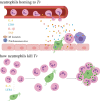Neutrophil interactions with the sexually transmitted parasite Trichomonas vaginalis: implications for immunity and pathogenesis
- PMID: 32873151
- PMCID: PMC7536067
- DOI: 10.1098/rsob.200192
Neutrophil interactions with the sexually transmitted parasite Trichomonas vaginalis: implications for immunity and pathogenesis
Abstract
Trichomoniasis is the third most common sexually transmitted infection in humans and is caused by the protozoan parasite, Trichomonas vaginalis (Tv). Pathogenic outcomes are more common in women and generally include mild vaginitis or cervicitis. However, more serious effects associated with trichomoniasis include adverse reproductive outcomes. Like other infectious agents, pathogenesis from Tv infection is predicted to be the result of both parasite and host factors. At the site of infection, neutrophils are the most abundant immune cells present and probably play key roles in both parasite clearance and inflammatory pathology. Here, we discuss the evidence that neutrophils home to the site of Tv infection, kill the parasite, and that in some circumstances, parasites possibly evade neutrophil-directed killing. In vitro, the parasite is killed by neutrophils using a novel antimicrobial mechanism called trogocytosis, which probably involves both innate and adaptive immunity. While mechanisms of evasion are mostly conjecture at present, the persistence of Tv infections in patients argues strongly for their existence. Additionally, many strains of Tv harbour microbial symbionts Mycoplasma hominis or Trichomonasvirus, which are both predicted to impact neutrophil responses against the parasite. Novel research tools, especially animal models, will help to reveal the true outcomes of many factors involved in neutrophil-Tv interactions during trichomoniasis.
Keywords: Mycoplasma hominis; Trichomonas vaginalis; inflammation; neutrophil; sexually transmitted infection; trogocytosis.
Conflict of interest statement
We declare we have no competing interests.
Figures

References
-
- Organization WH. 2018. Report on global sexually-transmitted infection surveillance.
Publication types
MeSH terms
Substances
Grants and funding
LinkOut - more resources
Full Text Sources
Medical

